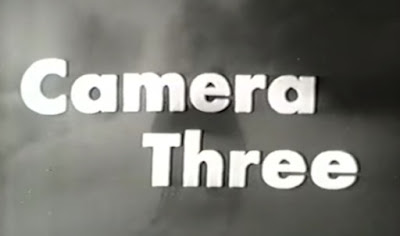This was the era before high def. Frankly, in 1954, they hardly had any def whatsoever. Consequently, it is difficult to appreciate early television as it was experienced by the original audience (whose TV’s were small black-and-white screens on enormous consoles). However, the classy minimalist aesthetic of Robert Herridge’s Camera Three anthology series still holds up. Long considered lost, the fifth concluding installment of Camera Three’s Moby-Dick, directed by Frank Moriarty, screens as part of Anthology Film Archive’s Herridge program this Sunday.
As viewers ought to know, nearly the entire crew of the Pequod is doomed. They all realize it too by the start of the fifth episode. Starbuck just missed his chance to essentially “frag” Captain Ahab, whose obsession with the white whale will obviously end in disaster. Starbuck still tries to persuade Ahab to return to Nantucket, but the die is cast.
Moriarty and Herridge (the producer and screenwriter) never resort to plastic whales or drenching the cast with buckets of water. This is a Spartan set, consisting of little more than masts. The small ensemble relates most of the action in monologues, faithfully distilled (by Herridge) from Melville’s text. Yet, the stark use of light and shadow, as well as the cast’s powerful deliveries remain eerily powerful.
One of the saddest aspects of Camera Three’s adaptation of Moby-Dick is the hauntingly good performance of Gerald Sarracini as Starbuck. At the time, he was an emerging star on TV and Broadway, but a street fight cut his life tragically short. Had he lived, he might have been considered in the company of John Cassavetes and Ben Gazzara.
It is also quite a revelation to watch Earle Hyman, who is truly magnetic as Ismail. While Hyman did indeed enjoy a long career, he is unfortunately best known for playing Cliff Huxtable’s father on The Cosby Show (which has fallen out of favor, for reasons beyond his control), while his early prestigious work on Moby-Dick remains largely missing and/or unavailable.
Furthermore, Peter Mark Richman (who was a staple on 1950s-1970s TV, including The Twilight Zone) might contribute one of the best portrayals of Stubb, of any adaptation. Of course, the Ahab makes or breaks every Moby-Dick, but the now little-known A. Winfield Hoeny (who recorded several spoken-word 78s) completely looks and sounds the part.
Fortunately (since this is all we have), the fifth installment of Moby-Dick stands on its own quite well, but it is shame the entire adaptation remains essentially lost. It still represents some terrific television, featuring a number of recognizable character actors, at their finest. Very highly recommended (and not just as a novelty), Moby-Dick Part 5 screens this Sunday (5/11) at Anthology Film Archives.
